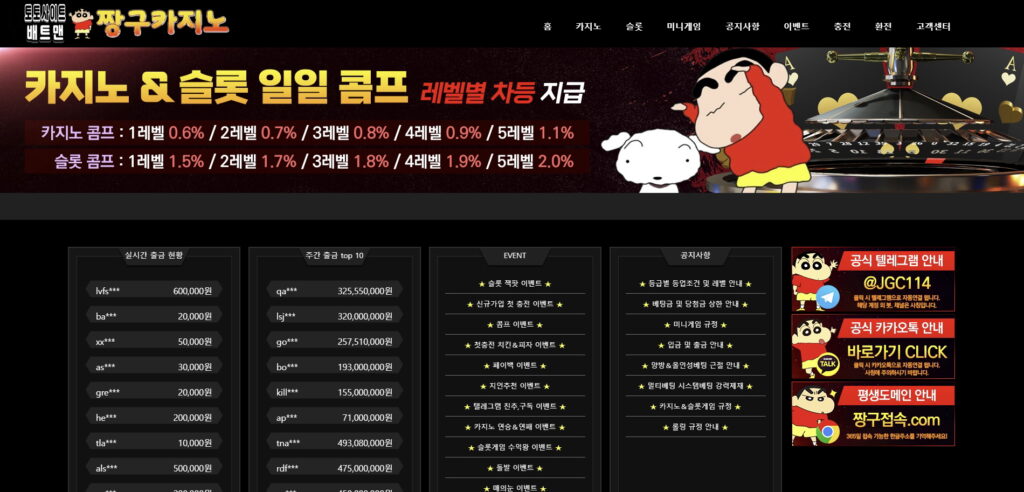짱구카지노
짱구카지노 국내 최고 수준의 검증 시스템을 갖춘 안전한 스포츠 및 카지노 배팅 플랫폼입니다. 수많은 이용자들로부터 신뢰받고 있으며, 누구나 안심하고 배팅을 즐길 수 있도록 다양한 시스템을 갖추고 있습니다.
이 사이트는 국내 1위 검증기관인 ‘배트맨’의 철저한 심사를 통과한 공식 인증 플랫폼으로, 먹튀 사고를 방지하기 위한 강력한 보안 체계를 운영하고 있습니다. 1억 원 이상의 보증금을 운영하며, 문제가 발생할 경우 전액 보상이 가능한 시스템이 마련되어 있어 이용자들은 더욱 안심하고 이용할 수 있습니다.
짱구카지노는 국내 모든 은행과 연동되는 입출금 시스템을 지원합니다. 토스, 카카오뱅크, 국민, 우리, 신한 등 주요 은행은 물론 다양한 금융 기관과의 실시간 거래가 가능하며, 입출금 속도와 정확도 면에서도 사용자 만족도가 매우 높습니다. 24시간 자동 시스템으로 지연이나 오류 없이 간편한 자금 이동이 가능합니다.
회원들을 위한 다양한 이벤트와 혜택도 준비되어 있습니다. 신규 회원에게는 가입 즉시 특별 보너스가 지급되며, 매일 출석 시 포인트 적립, 적중률에 따른 캐시백, VIP 전용 리워드 등 실질적인 혜택이 지속적으로 제공됩니다. 이처럼 단순한 배팅을 넘어, 재미와 혜택을 동시에 누릴 수 있는 플랫폼이 바로 짱구카지노입니다.
고객 지원 서비스 매우 뛰어납니다. 전문 상담원이 365일 24시간 실시간으로 대기하고 있으며, 배트맨 전용 파트너 코드를 통해 가입한 회원에게는 문제가 발생할 경우 100% 책임 보장을 약속드립니다. 모든 상황에 신속하고 철저히 대응하는 시스템이 마련되어 있어 사용자들은 더욱 안정적으로 서비스를 이용할 수 있습니다.
지금 짱구 카지노에 가입하시면 신뢰할 수 있는 배팅 환경과 풍부한 혜택, 빠르고 편리한 금융 시스템을 모두 경험하실 수 있습니다. 오직 짱구카지노에서만 제공되는 특별한 경험을 지금 바로 시작해보세요.
가입코드 : 7777
짱구 카지노 도메인 주소 접속하기
짱구카지노 고객 독점 혜택 소개
1렙 단폴 2000만 상한 5000만
1회 환전 한도 무제한
환전제한 시간없음
스포츠매충 15% (카지노 무한매충 3%)
가입첫충 40%
입금플러스 5+3 10+5 20+8 30+12 50+20 100+35
카지노 베팅한도 무제한
카지노 당첨한도 5천만
모든은행 가입가능
성인인증 1만 포인트
가입코드 : 7777
짱구 카지노 도메인 주소 접속하기
짱구카지노 대표적인 특징
짱구카지노는 국내 최고 수준의 안전성과 신뢰도를 자랑하는 배팅 플랫폼으로, 대한민국 No.1 검증 전문 기업인 배트맨의 철저한 검토 절차를 통해 공식적으로 인증을 받은 사이트입니다. 배트맨은 오랜 기간 축적해온 검증 노하우와 독자적인 심사 시스템을 바탕으로 사이트의 안정성과 자금 운용 능력, 사용자 보호 시스템까지 세밀하게 점검하여, 오직 기준을 만족하는 사이트에만 인증을 부여하고 있습니다. 짱구카지노는 이 과정을 성공적으로 통과함으로써, 이용자들에게 믿고 사용할 수 있는 최상위 수준의 안전 배팅 환경을 제공하게 되었습니다.
무엇보다도 짱구카지노의 가장 큰 장점 중 하나는 바로 전 금융권과의 연동을 통해 모든 은행 거래가 원활하게 가능하다는 점입니다. 사용자들은 특정 은행에 국한되지 않고, 자신이 편리하게 사용하는 금융기관을 통해 자유롭게 입금과 출금을 진행할 수 있으며, 이로 인해 시간과 비용을 절감하면서도 효율적인 자금 관리를 할 수 있습니다. 이러한 시스템은 특히 빠른 환전 처리와 안정적인 자금 흐름을 중요시하는 사용자들에게 큰 만족도를 제공합니다.
고객 지원 측면에서도 짱구카지노는 최고의 만족을 추구하고 있습니다. 언제든지 접근 가능한 24시간 운영 고객센터는 사용자의 문의에 빠르고 정확하게 대응하며, 단순한 질문부터 복잡한 문제 해결까지 친절하게 안내해드립니다. 경험 많은 상담원이 상주하고 있어 어떤 상황에서도 신속하게 문제를 해결할 수 있으며, 이용자가 느낄 수 있는 불편함을 최소화하고 있습니다. 이는 단순한 서비스 제공을 넘어, 진정한 사용자 중심의 케어를 실현하기 위한 짱구카지노의 철학을 보여주는 부분입니다.
이처럼 짱구카지노는 검증된 안전성, 편리한 금융 시스템, 풍부한 혜택, 그리고 신뢰할 수 있는 고객 지원을 모두 갖춘 토탈 배팅 플랫폼으로서, 누구나 안심하고 이용할 수 있는 환경을 제공합니다. 처음 방문하는 신규 사용자부터 오랜 기간 함께해온 충성 고객에 이르기까지, 모든 분들께 최상의 만족을 드리는 것을 목표로 끊임없이 노력하고 있습니다.
앞으로도 짱구카지노는 변화하는 환경 속에서도 변함없는 신뢰를 바탕으로 더 나은 서비스를 제공하고, 모든 사용자가 보다 즐겁고 안전하게 배팅을 즐길 수 있도록 최선을 다할 것을 약속드립니다. 여러분의 소중한 시간과 선택에 깊이 감사드리며, 짱구카지노는 항상 여러분 곁에서 최고의 배팅 경험을 제공하기 위해 한 걸음 앞서 준비하겠습니다.
가입코드 : 7777
짱구 카지노 도메인 주소 접속하기
짱구카지노 2025년 만족도 이벤트 안내
무한매충 15% 이벤트
간식 & 야식 이벤트
입금플러스 이벤트
투게더 당일횟수 이벤트
월급날 이벤트
텔레그램 친추 이벤트
다폴더 당첨 이벤트
국위선양 코리안리거 득점 이벤트
스포츠 무조건 지급 이벤트
아쉽다! 한폴낙 이벤트
돌발 이벤트
두근두근 첫 배팅
카지노 승부사 이벤트
지인추천 이벤트
매의 눈 이벤트
미니게임 연승 & 연패 이벤트
카지노 첫충 & 매충
리뷰 이벤트
페이백 이벤트
생일 이벤트
누적충전 입금 플러스 이벤트
복귀자 이벤트
투게더 성인인증 이벤트
명예의 전당 이벤트
대박! 인생역전 이벤트
출석체크 이벤트
입금 & 환전 지연 이벤트
가입코드 : 7777
짱구 카지노 도메인 주소 접속하기
짱구카지노 인기 제휴 게임
스피드키노
파워볼
스포츠
로투스
키노사다리
별다리
해외 카지노
에볼루션
파워사다리
토큰게임
BET365
벳게임 카지노






